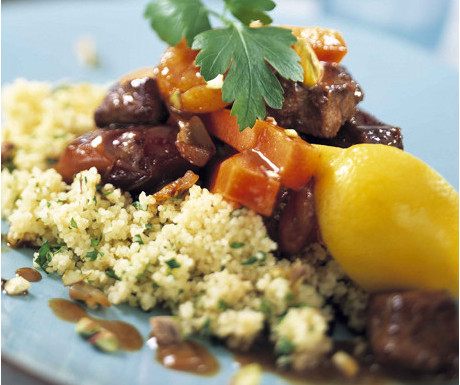Balboula is the original Berber version of couscous. Made from cracked barley, it is a delicious dish which is as good as it is hard to find on a restaurant menu. In a world where we are concerned with eating so many carbohydrates, and regular couscous is just like pasta in this regard, balboula offers a healthy alternativeit also happens to have more flavoura slightly nutty flavour which lends itself to great variation as described below. Balboula differs from regular couscous in that it is steamed three times instead of two. Serves 8 as a main course.

Ingredients
500g balboula, cracked barley for couscous
1 teaspoon of salt
2-3 tbps of butter for after the second steaming
2 tablespoons of olive oil1 cup of cold water, about, to start, plus more for each steaming
Vegetables and broth
2 medium yellow onions
2 teaspoons of turmeric
1 teaspoon of salt
1 teaspoon of freshly ground black pepper
4 tablespoons of olive oil
2 tomatoes
1 heaping tablespoon of concentrated tomato paste
4 carrots
1 half head of cabbage
200g courgettes, about 6 small ones
2 turnips
250g of pumpkin, a piece about the size of a hand
2 small aubergines
1 cup of dried fava beans
Directions
1. Start by preparing your ingredients for cooking. Soak the dried fava (broad) beans in water for several hours to rehydrate. Peel the onions, cut them in half from top to bottom (root end), then laying the flat on a board, cut them into thin moon-shaped slices. Chop the tomatoes into quarters from top to bottom. Peel the carrots by scraping them with the flat of a knife. Peel and trim the ends off of the turnips.
2. Prepare the couscous for its first steaming. Spread the balboula out in a large, shallow dish, add the salt, the olive oil, stirring each time to blend, then pour in the water. The amount of water should be feltit should be only as much as the balboula can absorb without leaving any excess water. Blend well with your hands to separate the grains, and set aside to swell.
3. Prepare the vegetables for the final dish. Fill a large bowl with water and set aside. Place each vegetable once prepared in this water. Scrape the carrots to peel them, then half lengthwise. Cut or pop out the hard inner core of the carrot. Split the courgettes lengthwise. Cut a small piece out of the skin side for decoration, at even intervals along the back of the courgette. Peel, top and tail the turnips and then quarter lengthwise. Cut the cabbage into 4 wedges. Slice the pumpkin into large chunks, about the size of walnuts, leaving the skin on. Scrape the stem end of the aubergines to remove any spines and fuzze and trim the stems of any brown spots. Cut up through the length of the aubergines in quarters, taking a piece of the stem with each cut.
4. Start the broth. Peel and chop the onions, leaving them in half moons. Toss along with the spices and the quartered tomatoes into the bottom of a couscoussier. Saut on medium heat until cooked, stirring occasionally, for about 5 minutes. Cover completely with water and bring to the boil. When the broth is just boiling, toss in the carrots and the cabbage that are soaking in the water. Cook thus for 10 minutes.
5. Prepare the couscous. Start by wrapping the bottom of the couscoussier with folds of tin foil around the edges to help create a tighter seal between top and bottom (this prevents the steam from escaping). Pour the resting balboulainto the top half of the couscoussier and gently fit it into the bottom with the steaming broth. Steam, uncovered, for 20 minutes.
Pour out the balboula into the large flat dish, add a cup of cold water, poured over your hands, as you fork your fingers through the balboula to break it up and prevent it from clumping.
Add the remaining vegetables that have been soaking in the water, as well as the fava beans to the broth, and add water to the broth to just cover the new additions.
Return the balboula to the top of the couscoussier for its second steaming and fix the top on the bottom above the broth. Steam thus for 20 minutes. Again pour out the balboula into the large flat dish. Add the pat of butter and stir to melt. Again add cold water and mix with your fingers to prevent clumping.
Add the heaping tablespoon of concentrated tomato paste to the broth and stir in gently to mix. Add water to keep the level in the liquid now to half the height of the vegetables.
Return the balboula to the top of the couscoussier for its third and final steaming. After 20 minutes it is ready.
6. Serve. Pour out the balboula into the dish you would like to serve it in, mounding it up like a mountain then hollowing out the centre like a volcano. Place the vegetables in an ordered way inside and around the mound, taking care to lay them out in an attractive way. Pour over a good amount of the sauce. Reserve the remaining sauce and serve in a bowl for those who wish to eat more.